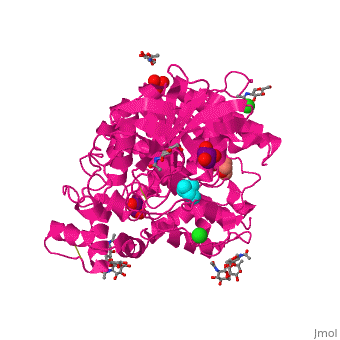Butyrylcholinesterase: Difference between revisions
Michal Harel (talk | contribs) No edit summary |
Michal Harel (talk | contribs) No edit summary |
||
| Line 2: | Line 2: | ||
[[Image:HuBChE.png|left|300px]] | [[Image:HuBChE.png|left|300px]] | ||
Revision as of 10:57, 15 November 2015

FunctionButyrylcholinesterase (BChE) is an enzyme widely distributed throughout the body in humans, but particularly prevalent in serum, where it occurs as a tetramer of catalytic subunits. It is distinguished from the homologous enzyme, acetylcholinesterase, by its ability to hydrolyze the non-natural substrate butyrylcholine as well as the neurotransmitter, acetylcholine. RelevanceBChE biological role remains obscure, but mutations in the human BCHE gene result in prolonged post-surgical apnea due to the inability of the mutant BChEs to hydrolyse the local anaesthetic, succinylcholine. BChE finds medical use as a bioscavenger for overcoming organophosphate (OP) nerve agent and insecticide intoxication by interacting rapidly with the toxic agents. |
| ||||||||||
3D structures of BChE3D structures of BChE
Updated on 15-November-2015
Additional ResourcesAdditional Resources
For additional information, see: Alzheimer's Disease
